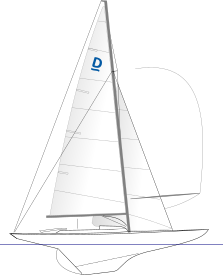 Class symbol | |
 | |
| Development | |
|---|---|
| Designer | Johan Anker |
| Location | Norway |
| Year | 1929 |
| Design | One-Design |
| Name | International Dragon |
| Boat | |
| Crew | 2–4 Maximum crew weight: 285 kg (628 lb) |
| Draft | 1.20 m (3 ft 11 in) |
| Hull | |
| Type | Monohull |
| Construction | Carvel GRP Cold moulded plywood Composite |
| Hull weight | 1,700 kg (3,700 lb) |
| LOA | 8.90 m (29.2 ft) |
| LWL | 5.66 m (18.6 ft) |
| Beam | 1.95 m (6 ft 5 in) |
| Hull appendages | |
| Keel/board type | Fixed |
| Rig | |
| Rig type | Bermuda rig |
| Sails | |
| Mainsail area | 16.0 m2 (172 sq ft) |
| Jib/genoa area | 11.7 m2 (126 sq ft) |
| Spinnaker area | 23.6 m2 (254 sq ft) |
| Upwind sail area | 27.7 m2 (298 sq ft) |
| Racing | |
| D-PN | 89.5 |
| RYA PN | 986 |
| Former Olympic class | |




The Dragon is a one-design keelboat designed by Norwegian Johan Anker in 1929. In 1948 the Dragon became an Olympic Class, a status it retained until the Munich Olympics in 1972. The Dragon's long keel and elegant metre-boat lines remain unchanged, but today Dragons are constructed using the latest technology to make the boat durable and easy to maintain. GRP construction was introduced in 1973 and the rigging has been regularly updated.[1]
The Dragon class is actively represented in over 26 countries on 5 continents. By 2004 there were 1,444 boats registered, and the number of boats built has averaged 45 per year. There are many more which are used for day sailing. The World Championships are held in every odd year and the European Championships are held annually. The Gold Cup, which can only be held in certain specified European countries, is unique in that all six races count without discard. It is held annually and often attracts over 100 entries, usually starting in one fleet.
A strong Class Association manages the class rules carefully to ensure safety, high quality and uniformity. Spars and sails have a wide range of adjustment during racing, allowing a skillful crew to optimize the boat for any conditions. Crew weight limits and restrictions on hiking out allow the Dragon to be raced successfully by a range of ages and both genders. It is possible to tow the Dragon behind many vehicles. It is often dry-sailed.[clarification needed] It may be raced against boats of other classes, employing a Portsmouth Yardstick handicap of 986[2] or a D-PN of 89.5.[3]
- ^ "Some history of the Dragon class at britishdragons.org". Archived from the original on 4 May 2016. Retrieved 28 April 2016.
- ^ "RYA Portsmouth Yardstick Scheme 2007" (PDF). Royal Yachting Association. Archived from the original (PDF) on 18 May 2015. Retrieved 21 August 2012.
- ^ "Keelboat Classes". US Sailing. Archived from the original on 16 August 2012. Retrieved 31 July 2012.